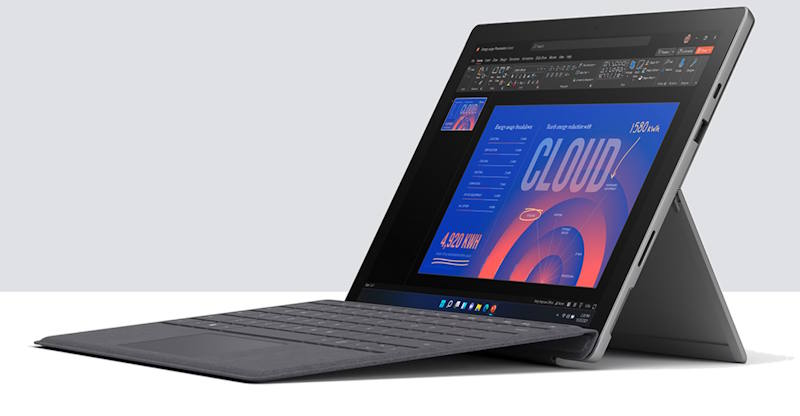Released in early 2021, the Microsoft Surface Pro 7+ was an unexpected yet welcome addition to the Surface lineup. Designed primarily for business and education users, this model refined the Surface Pro 7 with upgraded internals, improved battery life, and long-awaited features like a removable SSD. But did it bring enough to be considered a significant step forward? Let’s explore what made the Surface Pro 7+ stand out and where it still had room for improvement.
The Model Name and Its Purpose
Unlike previous Surface devices, Microsoft added a “+” to the name instead of launching a Surface Pro 8. This naming convention signified that it was an incremental upgrade rather than a complete overhaul. The Surface Pro 7+ mainly targeted businesses and enterprise users, offering enhanced performance and security while maintaining the 2-in-1 hybrid form factor that Surface fans loved.
What’s New? Key Upgrades Over Surface Pro 7

Performance Boost with 11th Gen Intel Processors
One of the most significant upgrades was the jump to Intel’s 11th Gen Core processors (Tiger Lake). Users could choose from Core i3, Core i5, and Core i7 variants, all offering improved efficiency and faster speeds. The integrated Intel Iris Xe graphics provided much better performance for light gaming and creative work compared to the older Intel UHD Graphics in the Surface Pro 7.
Improved Battery Life
Battery life was a major improvement, with Microsoft claiming up to 15 hours of usage, compared to the 10.5 hours of the previous model. This was mainly due to more efficient processors and software optimizations, making it a better choice for professionals on the go.
Removable SSD for Better Storage Upgradability
For the first time in a Surface Pro (excluding the Surface Pro X), Microsoft introduced a removable SSD, making it easier for businesses to upgrade or replace storage. This feature was especially useful for IT departments that needed to manage multiple devices.
Optional LTE Connectivity
A much-requested feature finally arrived: LTE support. The Surface Pro 7+ offered a 4G LTE option for Core i5 models, allowing users to stay connected anywhere without relying on Wi-Fi.
Enhanced Cooling and Thermal Efficiency
With better cooling, particularly on fanless Core i5 models, the Surface Pro 7+ ran quieter and cooler compared to the Surface Pro 7. This made it more comfortable for long work sessions.
What Stayed the Same?
While the internals received a solid upgrade, some aspects remained unchanged:
- Display: The device still featured a 12.3-inch PixelSense touchscreen (2736 x 1824 resolution), which was excellent but identical to its predecessor.
- Design: The chassis and port selection were the same, including a USB-C (without Thunderbolt 4) and USB-A port.
- Type Cover & Surface Pen Support: Accessories from previous models remained compatible, which was a positive for existing Surface users.
Where It Fell Short
Despite the improvements, the Surface Pro 7+ wasn’t perfect. Here are a few drawbacks:
- No Thunderbolt 4 Support: Many users hoped for Thunderbolt connectivity for faster external storage and eGPU support, but Microsoft left it out.
- Same Old Design: While the Surface Pro 7+ was sleek, it still carried the aging thick bezels, making it look outdated compared to modern ultrabooks and tablets.
- No Consumer Availability at Launch: Since it was primarily aimed at businesses, general consumers had a harder time purchasing one unless they found workarounds.
- No 5G Connectivity: While LTE was a welcome addition, the lack of 5G support made it feel slightly behind in the evolving mobile connectivity landscape.
Verdict: Was the Surface Pro 7+ a Good Upgrade?
For business users, the Surface Pro 7+ was a strong refresh, addressing key enterprise needs like storage upgradability and LTE support. The performance improvements, better battery life, and cooling refinements also made it a solid productivity machine.
However, for consumers already using the Surface Pro 7, the differences weren’t drastic enough to warrant an upgrade. It was more of an evolutionary step rather than a revolutionary one. Those looking for a true next-gen experience had to wait for the Surface Pro 8, which brought more significant design and performance changes.
Final Thoughts
The Surface Pro 7+ was a smart move by Microsoft to cater to businesses that needed an improved yet familiar device. It wasn’t the most exciting release for general consumers, but for professionals needing power, mobility, and security, it was a worthwhile choice. If you’re considering a used or discounted Surface Pro 7+, it’s still a capable machine in 2025—just be mindful of its aging design and lack of Thunderbolt support.
Would you consider getting a Surface Pro 7+ today, or would you opt for a newer model like the Surface Pro 8 or Surface Pro 9? Let us know in the comments!